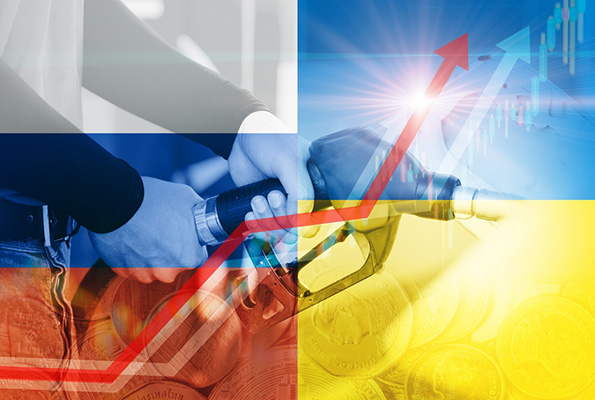While the date, February 24, 2023, marked one year of Russia’s invasion of Ukraine, Joe Biden’s promised “unwavering support” to Kyiv during a recent surprise visit to the war-torn country and Russian premier Vladimir Putin not mentioning a peaceful solution of the crisis in his annual address, means that the standoff will continue in 2023 as well.
The war has taken a toll on the markets. The sanction duel between Moscow and the US-backed Western Bloc has created an energy and food crisis, apart from shooting up energy prices. With Ukraine’s export routes facing Russian blockade, supply chain disruptions and their impacts have clearly been visible across the countries.
Oil prices were the one area of the global economy, which felt the conflict’s immediate impact.
According to Refinitiv, on 6th February 2022, the Brent Crude oil price was USD 80.99 bpd. From there, it reached its peak of USD 127.98 bpd on 8th March. It fell to USD 84 bpd on 12 September 2022 and reached its lowest point of 2022 on 9th December at USD 76.10 bpd.
However, OPEC+ also made the announcement of cutting down the daily production target, in order to support the market, as Moscow kept on pumping its allies China and India with the lion’s share of the oil supplies meant for other markets.
While some experts feel that the war impacted the global gas markets (especially in Europe) for a good part of 2022, others cite the oil prices spike as the conflict’s other fallout. And they believe that price volatility will continue to dominate the market in 2023 as well. China’s reopening post-COVID, the macroeconomic outlook and OPEC+ production cuts will be the other factors deciding the sector’s fate.
Dr. Carole Nakhle, CEO of energy research and advisory company Crystol Energy, told Zawya, “The conflict in Ukraine has played a bigger role in gas markets than oil markets, given the greater liquidity of the latter and the ease with which trade flow can be redirected.”
“Initial fears of major supply disruptions, with potential for the loss of production of between three and five million barrels per day (Mb/d), did not come to pass, but the macroeconomic outlook, including China, and OPEC+ production cuts were important drivers,” she remarked further.
“The above factors will continue to shape the market with China playing a more notable role. However, it also depends on the development with the conflict in Ukraine. Russia can still activate the ‘nuclear’ option and cut its supplies significantly and which in turn will result in price spikes and greater volatility,” the expert said.
Ehsan Khoman, head of emerging markets research at MUGF, said that it was China, not Russia, which was the largest oil shock of 2022.
“More Chinese-led demand was lost than Russian-led supply decoupled,” he said.
“The Chinese economy was overwhelmed by policies leading to prolonged and stern COVID-19 lockdowns,” he added, while mentioning that the acute deleveraging of the country’s property sector, drove recent oil price weakness.
Ehsan Khoman also cited aggressive rate hikes as a reason to slow down demand growth, as a strong US dollar throughout 2022 further capped energy prices. Oil markets are now priced and destocked for a recession that he said was likely to be ‘mild, at best’.
He, however, remarked that China’s COVID-19 and property sector policies have been reversed at “astounding speed”.
“The biggest risk is that against extremely low inventories and thin spare capacity, it will not take much for oil demand growth to hit the wall of supply scarcity,” Ehsan Khoman remarked further.
“There is a risk that as China fully reopens later this year that the global oil markets may undergo the same pressures as what the European economy experienced with gas in 2022,” the expert warned.
Private banking group Lombard Odier said after the initial oil price spike, slowing global growth and demand reduction in China saw prices dip below pre-Ukraine invasion levels from November 2022 onwards.
The bank said, “Demand prospects now constitute a key driver of oil prices. Meanwhile, the conflict’s impact has become more limited than many had expected, with Russian oil production and exports remaining resilient despite sanctions, even though the bulk of shipments have been rerouted from Europe.”
The bank’s forecast for the 2023 price remains largely unchanged, as it projects USD 85 per barrel in the first quarter, increasing to USD 90-95 per barrel for the remainder of the year.



